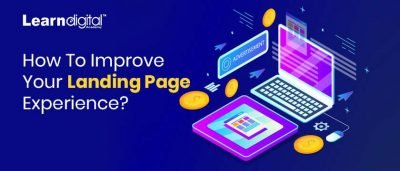
Is Google saying your landing page experience is below average? Cannot generate sales through ads? Read on to get some smart tips to optimize your landing page!
What are Landing Pages?
Landing pages, also known as lead capture pages, or destination pages, are single web pages that open when a visitor clicks a link in an email, or ads in Google, Bing, etc. A Landing page is created for marketing and advertising campaigns, and lead generation with a call to action button or link. (It is not to be confused with the homepage, which is the main page of a company).
There are two types of landing pages: References and Transactions
Reference: landing pages present clear, concise information on products or services, text messages, and images.
Transaction: pages include forms to be filled by the customers for getting information and to send emails.
What is the purpose of a landing page?
The main purpose of a landing page is to convert visitors to leads. It has forms that enable you to retrieve contact information from a customer in exchange for the desired offer.
A homepage has many links to other portals like the about us page, careers, contact us, etc where a customer may not be able to make a purchase. A landing page has fewer links focused completely on enabling a customer to make purchases. It contains ads and forms, whereas the homepage doesn’t.
How to optimize a landing page?
Here are the few tips to follow to improve your landing page experience:
1, Relevant content: Keep your content relevant and trending on the site because you don’t want the customers distracted from the main goal and leave the page. Be clear and straight to the point. Make use of H1, H2, and H3 tags and be clear in what the heading says.
2.Keywords: Keywords are quite important in ads too, so make sure the page is packed with enough, relevant keywords in the heading, title, and content. Keywords can be of status above average, average, and below average. The first two status means that there is no problem with the landing page experience. If the keyword is of below-average status, then you need to consider making some changes. The keywords in your landing page should match with those in the ads for maximum optimization.
3.Loading speed: 53% of the customers are likely to ditch a landing page if it is taking longer than 3 seconds to load.
Adding large size images can slow down your page and what you can do about it is use tools like TinyPNG to compress an image without compromising on the resolution, and upload it on the landing page to help it load faster. If your landing page is having problems with loading time, you can determine the reasons for it using tools in Google PageSpeed Insights. Another tool to help with speed is Pingdom speed test.
4. Make navigation easy for mobile use: Some landing pages formatted for desktop use may not be proper for mobile use.
Avoid pop-up ads that annoy customers on the landing page. It’s the biggest stinker! It distracts them from finding information about what they want and they will immediately abandon the page.
Make it easy to order a product on the mobile phone by organizing and designing the site accordingly.
5. Transparency:
- Provide information about your company,
- What kind of products and services you offer,
- Detailed, accurate information on the product a customer is about to purchase,
- Give a clear call to action. Make “contact us” button visible,
- Provide a reasonable explanation when for requesting personal details about the customer,
- Prove that your company or the site is trustworthy and not spam. Establishing trust with your customers is crucial in converting to leads.
- Share a few positive reviews and testimonials from other customers.
- Make the terms and conditions section visible and clear or provide a link to it.
6. Test it with a user perspective: You are advertising for the customers, not for Make it about the customers, always. Test the page before finalizing it for a user-friendly experience.
7. Keep the content short: A lengthy form can overwhelm a customer and make them leave. So, keep whatever forms necessary for the landing page, error-free, short, and relevant. The customers should feel at ease navigating from search to ads, to a landing page, and your business. Provide an escape off the landing page in case a customer wants to exit the page, as Google tends to punish those sites that trap the customers without a way out.
Experiment with different fonts, style, length of the content, and size of the buttons to please the customers. Nothing beats an eye-candy content to make them stay on the page!
8. Call to action: The most inviting call to action buttons (provided that the content is designed well) are, “BUY NOW”, “SIGN UP FOR FREE”, etc. The call to action button is the most important feature on your landing page. It is what the landing is all about. Make sure this button is visible and easy to click on.
Sometimes the customer may be unsure of clicking the call to action button as they may want to know more about a product. In such cases, the “contact us” or “call us” button should be visible clearly. Any facts or claims about the product or shipping should be verified before mentioning it on the site.
9.Ending: After the purchase or whatever action has been made, the landing page should follow up with a thank you page to confirm the receipt. Emails can also accompany a thank you page as it helps the customers keep track of their purchase or sign-ups.
Why are landing pages important?
Do you see your website converting to leads? Of Course not. Websites don’t have a singular goal of converting visitors to leads. They don’t provide a specific outlet to make a purchase. Having a landing page solves that problem as its only goal is lead conversion. It drives better traffic and gives you an insight into prospects’ demography. Sending too many emails, social media links or posts can throw off the leads. It is more effective to create a separate portal for all that by creating a landing page. The information collected from the landing page will tell you if the leads convert to sales, what kind of visitors are making a purchase and converting. This information will make it easier for the marketing team to communicate with the sales team. It’s not a rule to have just one landing page, in fact, having multiple landing pages gives more opportunities for lead conversion. So go ahead and take that step to move your business forward!
Are you looking for Digital marketing training program? Contact us through email at [email protected]. We are Best Institute for Digital marketing training in Bangalore.


